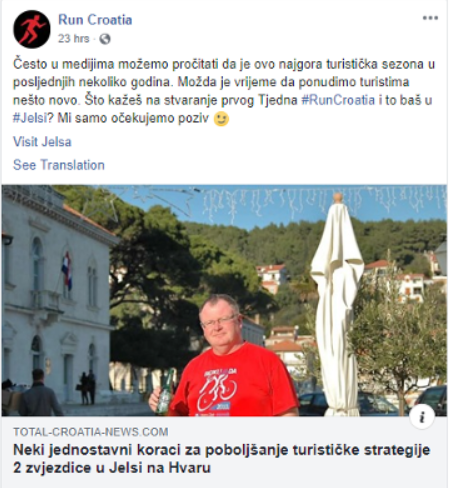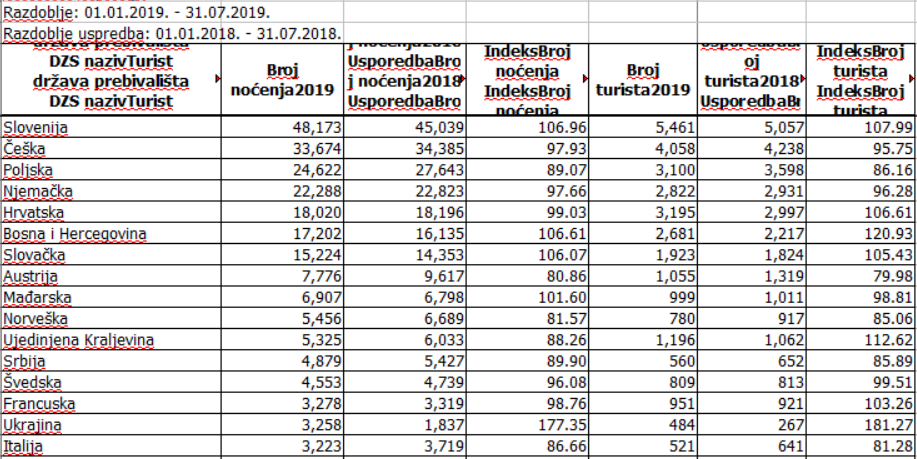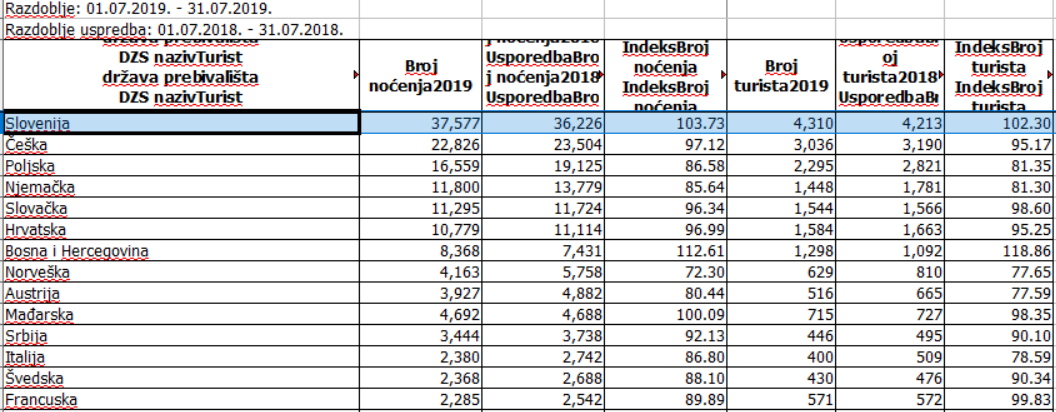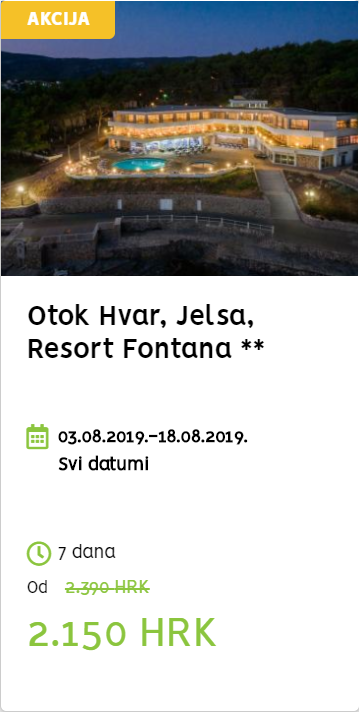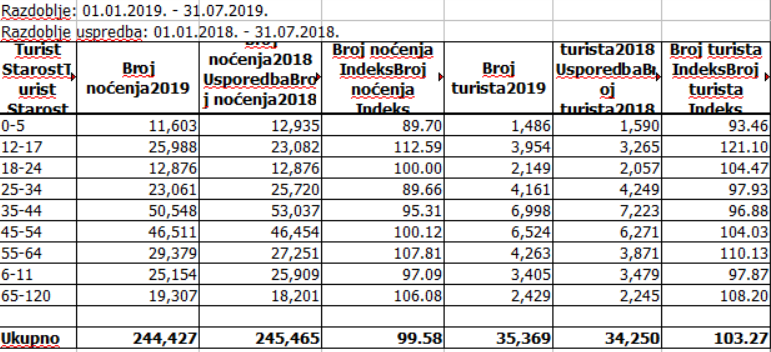Socially Distanced Za Krizen 2020 WILL Happen: Livestream on TCN
April 8, 2020 - 500 years of UNESCO tradition WILL continue on Hvar tomorrow night but Za Krizen 2020 will be a socially distanced procession in the corona era - and partially available on livestream on TCN from 21:30 tomorrow night.
This is an incredibly hard article to write, as I need to get every word right or I could get in trouble. There is a LOT unsaid behind this article, which perhaps will be left unsaid. My understanding is that the final decision on the religious procession Za Krizen 2020 reached the desk of Prime Minister Andrej Plenkovic. And a decision has been taken - Za Krizen 2020 WILL go ahead tomorrow night at 22:00 - as it has every year for about 500 years on Maundy Thursday - albeit with a radically different look in this socially-distanced corona era.
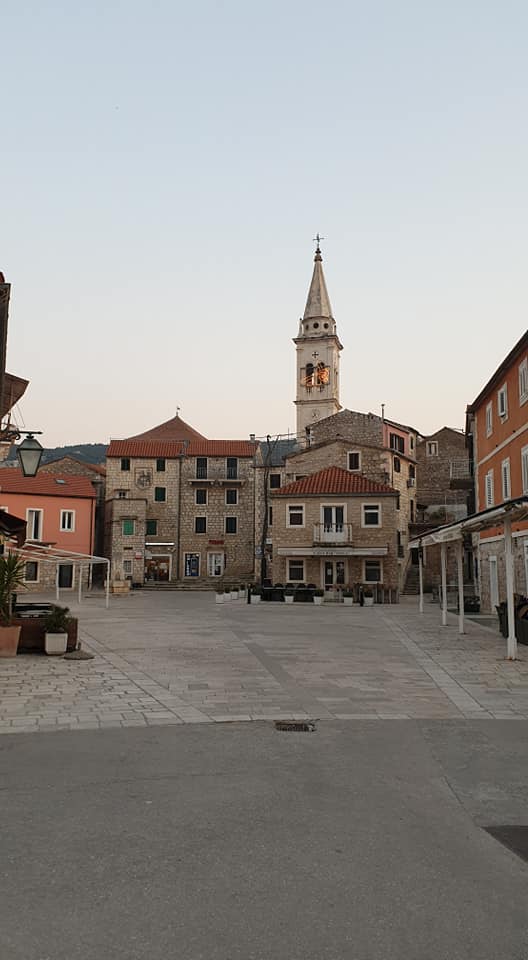
The main square of Jelsa tonight, which traditionally was the focal point of the procession, which has survived occupation by the Italian fascists in 1943, took place in the Sinai Desert in a refugee camp in Egypt in 1944, and took place in the godless Socialist years of Tito. You can learn more about that, and the procession in a previous article on TCN - 'Za Krizen' on Hvar Overcame Fascists, Tito, Sinai Desert, But Will It Beat Corona?
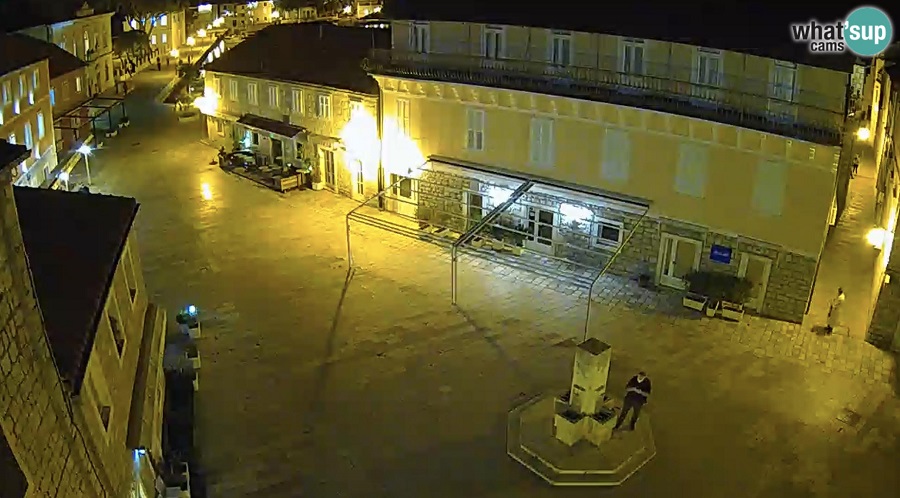
This is how Za Krizen looks in a normal year - the start of the Jelsa procession, one of six simultaneous processions which leave from Jelsa, Pitve, Vrisnik, Svirce, Vrbanj and Vrboska.
Clearly such a procession is NOT possible in the current climate. And this is NOT what Za Krizen 2020 will look like.
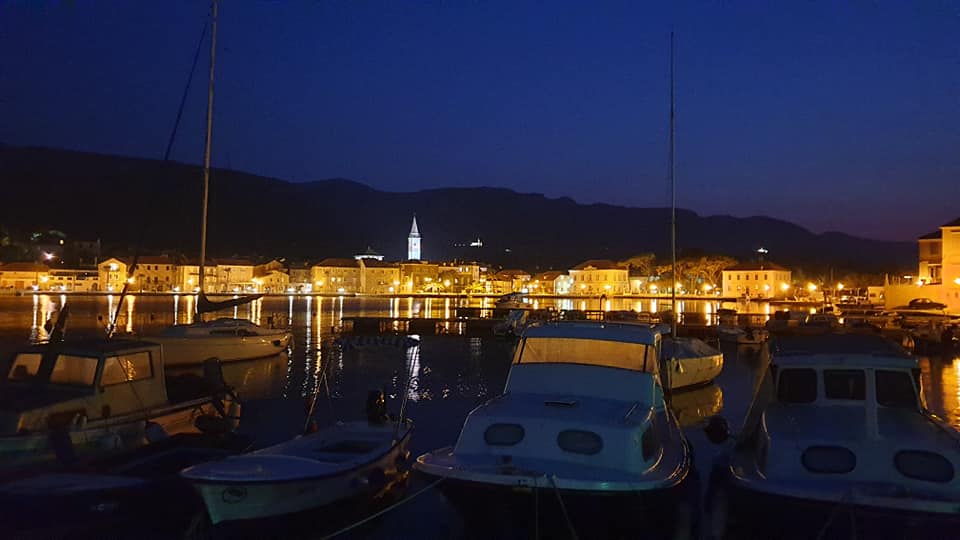
Jelsa tonight, as beautiful - and as empty - as I have ever seen it.
The sound of the church bells. They will fall silent tomorrow night until Sunday, as per the Holy Week tradition in Jelsa.
The discussion on whether or not to allow the procession to take place in some format has reached the very top echelons of the Croatian government. Health Minister Vili Beros, himself from Jelsa, stated that he was in favour of delaying the procession until September last week.
Clearly the idea of hundreds of people taking part was out of the question. Discussions ensued, and one suggestion was that each procession would be reduced to just five people - the crossbearer and four acolytes, a far cry from the 20 or so acolytes and the hundreds or thousands of pilgrims who walk through the night.
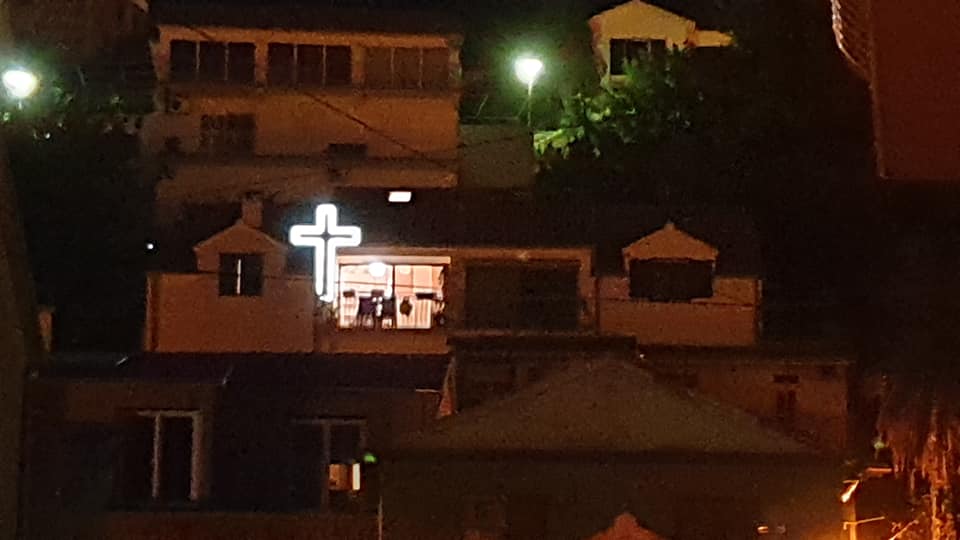
(A cross burns brightly outside the home of the Jelsa crossbearer, as per tradition)
My understanding is that the crossbearers asked for more acolytes to help them through the long night, and a decision was taken which involved PM Plenkovic (himself a Hvar man, who took part in Za Krizen back in 2017, as reported by TCN).
The final decision is that each procession will be allowed 15 participants (slightly more than the 12 allowed by the Italians in 1943), with five more singers following by car. Social distancing rules will be enforced.
And - and this will be VERY important to the millions of devout self-isolating Croatian Catholics here and in the diaspora - parts of Za Krizen 2020 will be available live from Jelsa, on the TCN Facebook page from 21:30 tomorrow night. At an incredibly important time of year for Croatians - Easter - the chance to see this religious tradition live from Hvar will no doubt give fortitude to many.
If all goes well, TCN will have a live feed from both the Jelsa church and the Jelsa main square from 21:30 tomorrow night until 08:00 on the morning of Good Friday. You can like the TCN Facebook page here, where the feed will appear.
I called the head of the Jelsa Civil Protection Headquarters today, and thereafter the head of Hvar police. Very productive discussions, in which I explained my socially distanced media coverage plans for tomorrow night. Both seemed fine but suggested that I request clearance from Jelsa Mayor Niksa Peronja. Mayor Peronja has just replied that I have clearance to report, so I will do the best I can to capture as much as I can of this tradition which means so much to the people of Hvar.
Last year, I managed to capture all six processions through the night.
I don't expect that level of access this year, but I will report back with the best I can do from a safe distance.
We will post the livestream link on TCN FB tomorrow night at 21:00.
And if you are wondering why Za Krizen 2020 is such a big deal, this is one of my favourite videos ever about Hvar traditions, which explains it all from the point of view of a crossbearer.
Restarting Croatian Tourism from the UK After the Homeland War: a Travel Agent's Tale
March 28, 2020 - How do you restart tourism when it comes to a crashing halt? Former travel agent Martin Gannon, on how tourism from London to Croatia got going again after the Homeland War, and the experience and reception those first guests received.
One of the strangest things about this VERY period of world history is how dated things get so very quickly. Something that seemed like a new revelation yesterday already belongs to a previous era a day later. Three days ago I wrote an article called Hope v Reality: Will There Be a 2020 Tourist Season in Croatia? is order to share some insights with people making decisions on strategy for this tourist season. By the time the article appeared in Croatia on Index last night, it was already a little dated.
So with tourism coming to an abrupt halt, how will it get started again when all this madness is over? As I wrote yesterday, 25 years ago, the Jelsa hotels were full all year, but there were no tourists. There were used to house refugees from other parts of Croatia and Bosnia.
But what happened after the war, and how did tourism restart? I asked Martin Gannon, the original crazy Englishman who fell in love with Jelsa back in 1980, how his travel business got back on its feet after the war.
Here is his very heartwarming account, with some things to think about and take encouragement from, perhaps.
My travels to visit Croatia and Jelsa during and at the end of the Homeland War brought me to this incredible place that I had known since 1980. I had started work at the end of 1980 for Saga in Porec in Istria looking after slighty more senior guests in Hotels as a holiday rep, then moving on to being a coach tour guide to British and American guests covering the whole of Former Yugoslavia. I saw tourism then as a mass enterprise, low-value, lots of people, simple hotels and very little private input. I continued with different organistations ending up as a senior manager with Pilgrim Holidays owned by Yugoslav Airlines (JAT) and brought in business travel and smaller hotels for British tourists a more quality product. And it sold unbelievably well.
Then tourism stopped with the Homeland war and the majority of hotels along the coast were needed to house refugees.
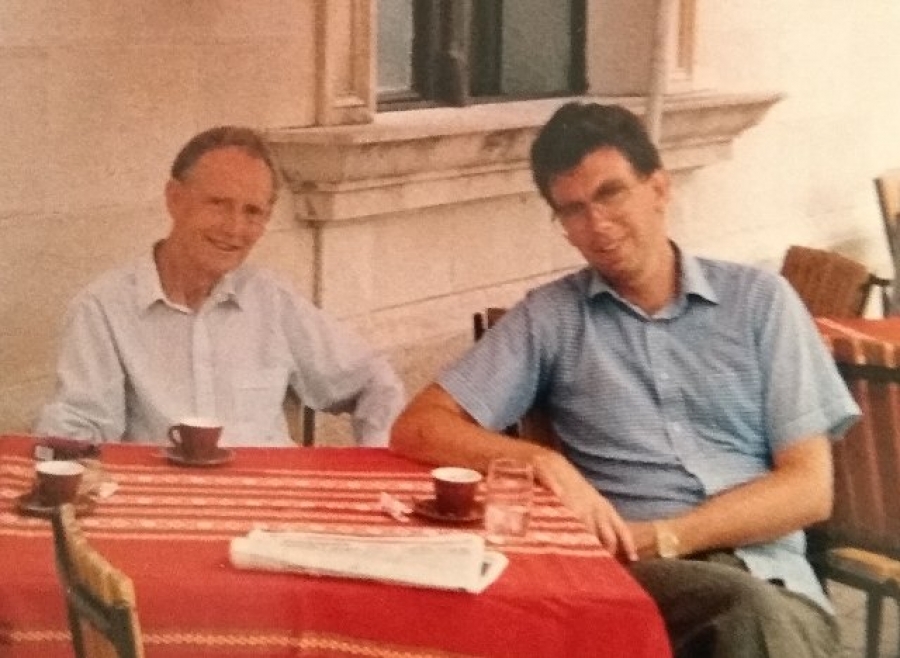
(Martin Gannon with his father in Jelsa)
I was with the Croatian community in London, helping with Caritas, so was still in contact with people I used to work with. One Croatian who owned a travel agency found there was a lot of interest still in people wanting to get to Medjurgorje from the UK and Ireland. Croatia Airlines had just taken delivery of its first Airbus A319. This was chartered every Saturday from May until October flying from London Gatwick to Split. At first the majority of tickets sold were for pilgrimages, but slowly we began developing more bookings for holidaymakers. One of the first contracts was with a small private hotel in Trogir called Hotel Concorde.
Slowly more apartments small private hotels began to make themselves known, and we advertised them as best as we could with very limited resources.
One of the larger hotels I contracted was the Mina Hotel in Jelsa, which I was delighted to bring back into tourism to get work back into the village.
Unfortunately, the number of British tourists was still low, but the Italians and Germans were returning in greater numbers.
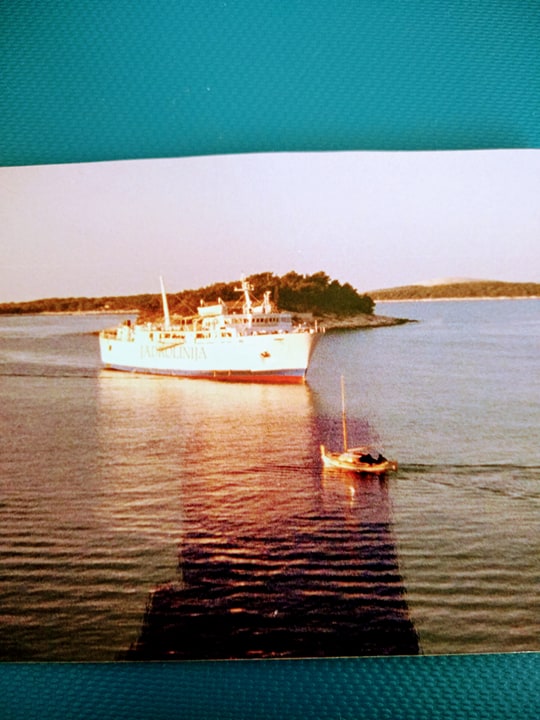
So what did these holidaymakers find when they came back? Pure Heaven, and I'm not exaggerating. Local people were delighted to see visitors again, from the friendly and kind help they would find in their apartments, from free wine, fruit and kind and caring advice, to a wonderful atmosphere of being appreciated. The amount of letters we received in the office from people who had been on holiday to Croatia saying it was the best holiday ever, was truly incredible.
In Jelsa the few restaurants that reopened served beautiful fresh fish literally caught in the bay. Fish was abundant as it had been subject to barely any fishing for years. Fresh vegetables grown in the owners' gardens, as they had had to start growing their own food to survive.
Café bars and restaurants would not rush you through, if you only spent a few Kuna it did not matter, you were there at least as a customer. People had survived on barely nothing, so now even as a small amount of money appeared they were grateful for it, not greedy for it.
It is difficult to exactly put in words the atmosphere, it was one of pure happiness, of contentment, we had got through the difficult times now there was a future, look after the guests and they will return.
When the war came to Kosovo in 1998-9 the British tourists almost disappeared, and it was a real struggle to get them to come to Croatia. But again Croatians stayed strong. It was a frustration, but by treating the tourists who came in a kind and generous way they never forgot, and they told others of their experience and slowly the numbers began to increase.
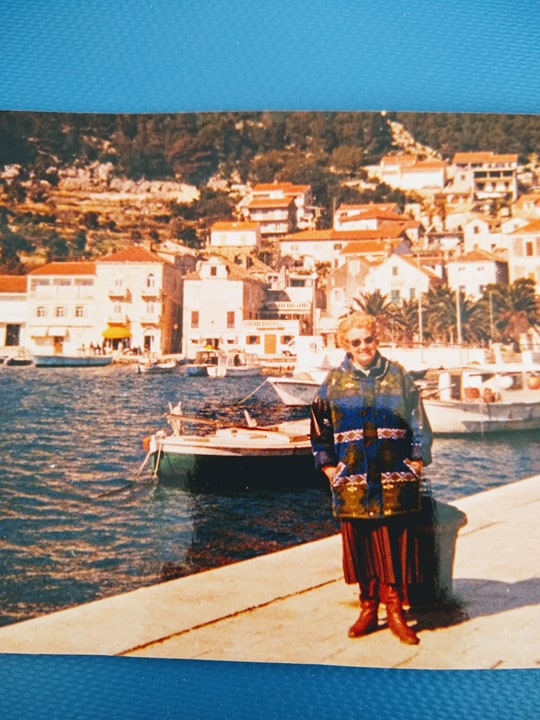
(Martin Gannon's mother on Hvar in the 1990s)
These visitors at this time, had true relaxing holidays, no enormous crowds, fresh local food, excellent wine, food in restaurants was homemade, not imported frozen fish.
I think now its an opportunity to reflect, and realise it's far better to enjoy a little, rather than be overcrowded and stressed. Croatia is a stunningly beautiful place, I have travelled the world, and know no other place like it,.My heart leaps when I get back there, I feel rejuvenated, and the wonderful kindness and caring of my Croatian friends is truly moving.
I know this year will be very difficult, but if tourism can return in style and delivery like those years in the late 90s and early 2000s , so it can after corona, and it will reap the benefits, in more ways than one.
You can learn more about Martin Gannon's tourism career from 1980 onwards in this lovely article on Eco Hvar.
25 Years Ago, Jelsa Hotels Were Full But There Were No Tourists
March 27, 2020 - It is 25 years since Jelsa hotels had no tourists, but back in 1995, there were very full, as a local resident recalls.
It is going to be a very strange summer for everyone. Having lived in a tourist destination (Jelsa on Hvar) and finding myself self-isolating here, the prospect of empty hotels and no tourism is hard to imagine, even before one imagines the pain that will cause the local economy. As I wrote recently in Hope v Reality: Will There Be a 2020 Tourist Season in Croatia?, while we all hope this will be over soon, a look at the realities of the situation and how the world will look on the other side make for some sober reading.
But Jelsa, and many other destinations in Croatia, are no strangers to the tourism season being ravaged. The Homeland War in the 1990s killed tourism, but that did not mean that Jelsa hotels were empty, far from it.
Instead of tourists, the hotels slowly filled with internally displaced people from Vukovar and other parts of Slavonia, followed by refugees from Bosnia. Jelsa schools accommodated the kids, and the new arrivals from war-ravaged areas began a prolonged stay.
I am very grateful to erstwhile TCN contributor and unpaid typo-controller-in-chief in the early days of Total Hvar, Vivian Grisogono, for this fascinating account of her recollections of the war years in Jelsa:
"I came over to Hvar as soon as the blockade was pushed back, possibly during my visit (bringing various bits of aid to Zagreb and Split) in June 1992, certainly for my Fact-Finding Mission on behalf of UNDP / UNHCR which I did between 9th & 21st August 1992. Whichever it was, my friends were delighted to joke that the aggressors had heard I was coming and taken their gunships away! as that happened just a few days before I got to the island.
Apart from the blockade, the island's little air strip was bombed more than once, and had not been repaired at the time of my visit.This left the island totally isolated and vulnerable: no Canadairs to deal with the frequent forest fires, and no emergency medical airlift service.
My itinerary was through Slovenia and Croatia, looking at the report I did, it was quite hectic! Was supposed to go to Serbia & Montenegro as well, but UN couldn't guarantee my safety, as technically I was still a Yugo citizen at the time. On Hvar Kruni Peronja was President of the Island (a post which is now defunct). The organization of facilities for the refugees was extremely impressive. I visited the Hotel Jadran, inspecting the (spotless) kitchen and living facilities. People making the best of it, but of course a hotel is not a true living space for families. Even less comfortable was the former children's holiday camp (Grebišće) where again the kitchen was spotless, but the living accommodation was sparse - rooms generally had 3 beds which took up almost all the available space, and the building was already in a state of disrepair (though not as bad as now)
My record shows that as at 17th August there were 624 displaced persons (many from the Vukovar region) and 3727 refugees on the island. 1323 were housed in private lodgings, the rest in hotels or former holiday camps. Refugees were provided with a special id card which entitled them to benefits such as food & lodging. Displaced people also received small amounts of money. At the time, electricity was severely limited in Dalmatia because of the occupation of the Peruća dam - there was a point when electricity was only available for a few hours at night. Food was in short supply, firstly while the blockade lasted, and then because of the transport difficulties across the country - remember that Knin was blockaded, and the road detour from the north to the south of Croatia along the coast was complicated, not to say fairly dangerous (I did it later on towards the end of the war, when the dangers were minimal, but just going over the pontoon bridge put up in place of the Maslenica Bridge was a hairy experience at night, even without people firing at you!). On Hvar, heating for the refugees and displaced persons had been a problem during the winter, and was set to be a problem again after the summer.
There was of course a lot of unemployment on the island as tourism was reduced to zero, and a lot of people had optimistically invested in their private tourist facilities when Croatia declared independence in 1991. Locals had priority for such jobs as were available, so refugees / displaced persons had little or no chance. The lack of meaningful activity and income created severe psychological hardship.
Disabled refugees could not be accommodated on the island, but there were plans to receive groups of convalescents for rest, recreation and rehabilitation. Some of the facilities which were mooted for the purpose could have been adapted for wheelchairs users. The programme would have provided employment, and would have been a long-term benefit for the island, but it didn't happen, and indeed facilities for disabled wheelchair users are still extremely limited.
The other thing of note was that the local authorities had taken great trouble to protect property belonging to absent Serbs at that time, being aware that one day the war would end and they would be coming back. The feeling was that those who had not participated in the war should be made welcome at that later time, and should not be given cause for resentment. Quite a lot of those properties were offered for sale at knock-down prices. (As you know, after the war a few Serb-owned properties were commandeered by various incomers, which was sad, but probably inevitable, given the level of anger and frustration which was engendered by five years of misery.)
On the positive side, a lot of Hvar residents went out of their way to help the refugees and displaced people feel comfortable, even though they themselves were suffering their own hardships among all the uncertainties of the war. Friendships were forged which lasted way beyond the end of the aggression. Some of the refugees / displaced persons remained on the island and carved out new lives for themselves. Hvar's exquisite environment is a great bonus, but it wasn't easy for anyone in those long years of the war and its aftermath."
You can learn more about Vivian's environmental initiatives for the island and wider world on her Eco Hvar website.
'Za Krizen' on Hvar Overcame Fascists, Tito, Sinai Desert, But Will It Beat Corona?
March 21, 2020 - It is a UNESCO tradition which has taken place each year for 500 years despite the challenges of fascism, socialism and the Egyptian desert. But will Za Krizen 2020 beat the coronavirus?
When the coronavirus spread throughout Europe, there was much talk about banning events and social gatherings. Most were focused on rock concerts or Premier League matches, but my mind turned to something a little closer to my heart. If this event were cancelled due to COVID-19, what a statement for history! For this event has been challenged many times before, in different trying historical circumstances. But it has always taken place each year at 22:00 on Maundy Thursday on a beautiful Dalmatian island.
Every year. For 500 years. Without exception.
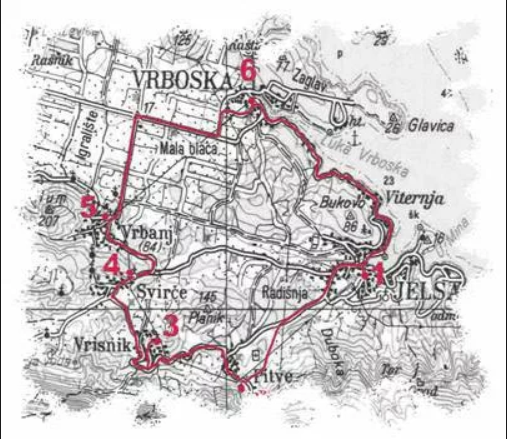
'Za Križen' (literally 'Behind the Cross') is a religious procession which is one of the most important events in the annual calendar of the people of central Hvar. At 22:00 on Maundy Thursday, a barefoot crossbearer, each from the six communities of Jelsa, Pitive, Vrisnik, Svirce, Vrbanj, and Vrboska, lead their acolytes and pilgrims on a 22-km procession of chanting, prayer and reflection through the other communities, before returning to their starting point around 07:00 on Good Friday. Several thousand people attend the event and walk through the night for this traditional procession, which was awarded the status of intangible UNESCO heritage back in 2009.

It is a procession which is steeped in history, heritage and pride. It is a great honour to carry the cross, and it is said that parents put their new-born babies on the waiting list for the honour. One of the best videos I have ever seen about the traditions of Hvar was Maja Zrnić's piece for Hvar TV following a Pitve crossbearer, Ivo Mileta, behind the scenes.
A really fascinating snapshot of a unique tradition which spans five centuries. The Italian fascists tried to ban it in 1943, but Za Krizen took place, albeit on a reduced scale.
In 1944, Za Križen took place in the Sinai Desert in Egypt, in a refugee camp in El Shatt. as refugees from Hvar insisted on honouring their traditions - you can read more about the incredible story of Dalmatian refugees in the Sinai Desert here.
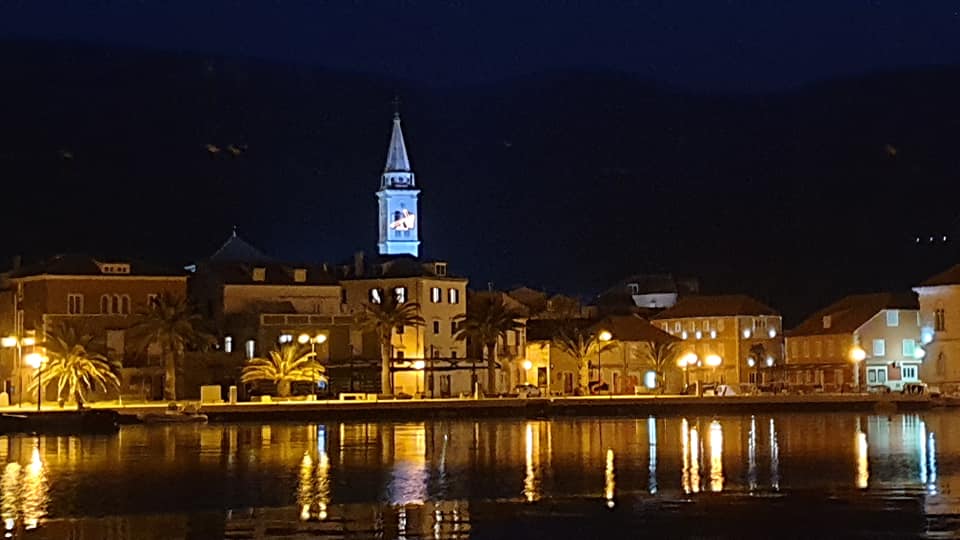
And, as the Pitve crossbearer in the video above shows, religious processions during the Tito socialist era were hardly encouraged.
Za Križen has overcome all these obstacles over its 500-year history. I managed to capture all six processions at various times on the night last year here.
But will Za Križen be able to overcome perhaps its biggest challenge yet - COVID-19?
With the ban on public gatherings and ferry transportation restricted to those with island IDs, it is clear that the many Hvar people living on the mainland will not return, and that there will be few to no pilgrims following the cross. But will the event take place?
Perhaps. And if it does take place, it will be one of the few events to actually be happy in these crazy times.
My understanding is that the current thinking is that the six crossbearers will definitely go, with perhaps a couple of assistants each, but nothing more. The mass gathering at the start and finish will not happen, and so it will be a rather curious affair for those who traditionally take part. The Vrboska crossbearer has apparently arrived from Canada, where he now resides, while the Pitve crossbearer Roman Radonić is the nephew of the youngest ever crossbearer, Sveto Marijan back in 1953, aged just 13.
It will undoubtedly still be a very special night, although - like everything else in the world right now - different.
I will bring you as much coverage as a responsible socially distanced journalist can. To learn more about the Za Krizen UNESCO tradition, check out the official UNESCO video below.
Life on Europe's Number 1 Island with All Bars, Restaurants Closed (VIDEO)
March 20, 2020 - So how does the Hvar lockdown look like? A wander around Jelsa the day after much of Croatia closed down.
It is just over 5 months since Hvar was voted the best island in Europe (it is!) by readers of Conde Nast in the prestigious Conde Nast Traveler Readers Choice Awards, the latest international endorsement of Croatia's premier island.
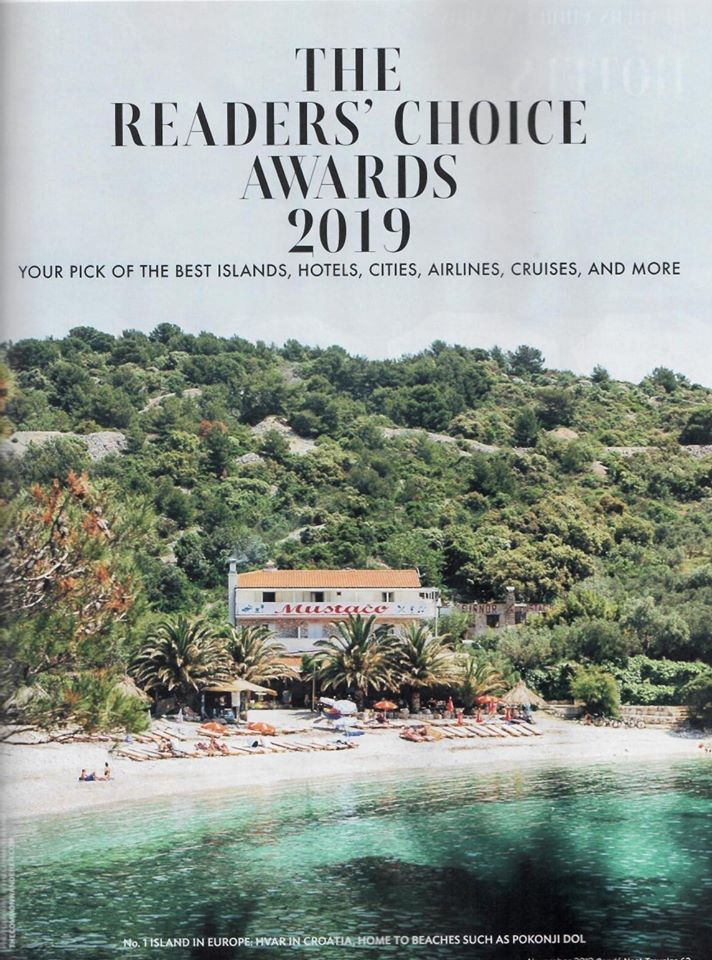
FIve months later, as Hvar and the rest of Croatia should be gearing up to another bumper tourist season, the country, like most of the rest of Europe, finds itself battling the coronavirus, with strict measures enforced to prevent its spread.
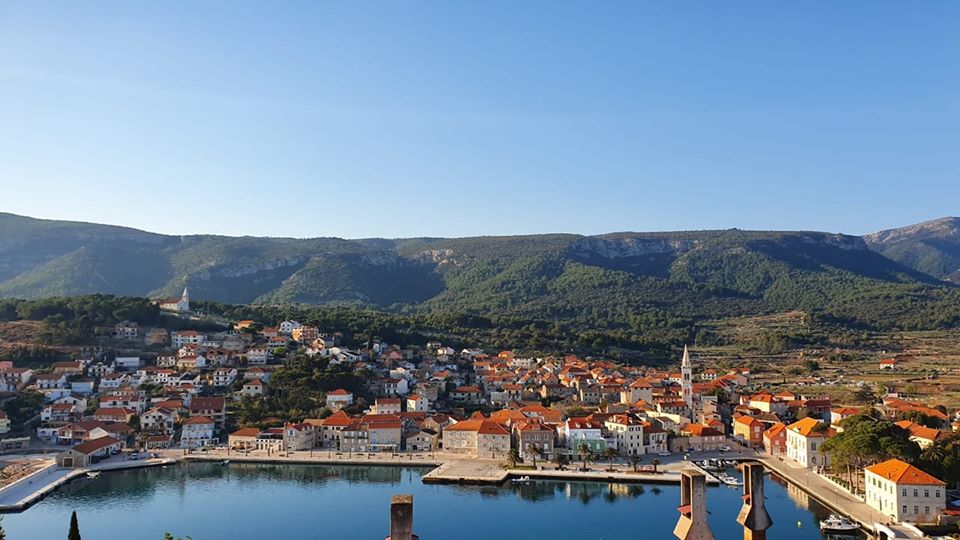
From the TCN terrace, life looks perfect. And from the TCN terrace, life really IS perfect. Rather than lose too much sleep over the lost tourist bookings of our holiday rental, we decided to relocate and self-isolate there. That endless sunshine and gorgeous terrace never fail to lift the mood.
But look a little further than the terrace, and life has changed drastically since the introduction of the new measures, as well as the growing awareness of the crisis.
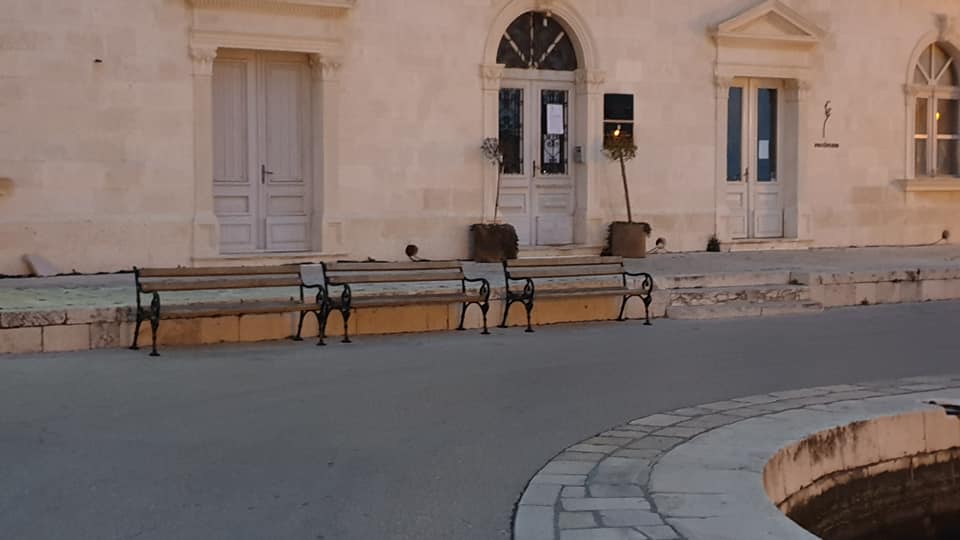
Island intellectual life has been suspended, with the collection wisdom of the wise old men of The Bench - whose knowledge has suggestions that there were the original prototype for Google - are nowhere to be seen.
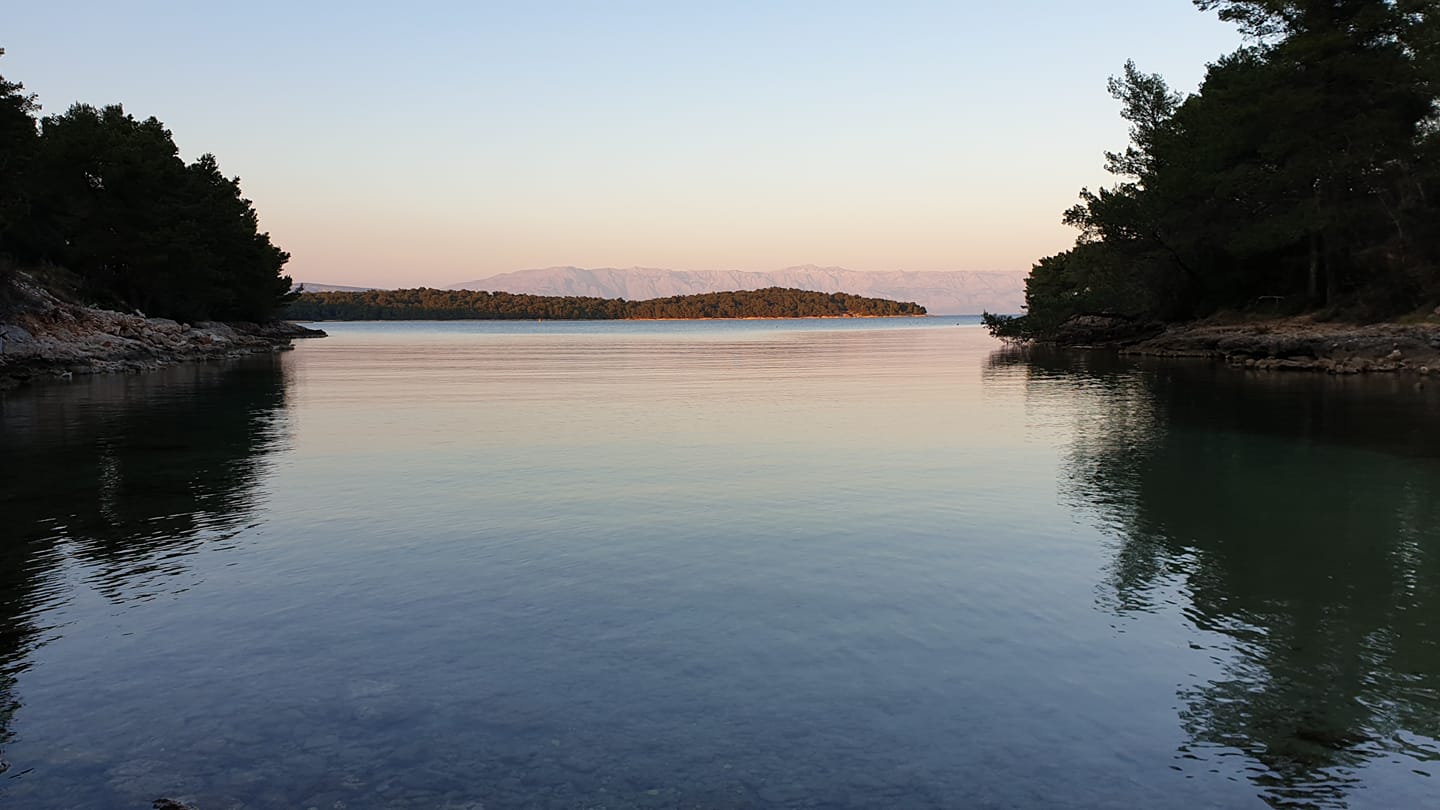
With so few people around, social distancing is not that difficult, and the further one gets from people, the closer one gets to nature.
It will be swimming season very soon, and the gorgeous Adriatic will still be there for you when all this is over.
As will the bars, cafes and restaurants of Jelsa. There is no denying that tourism is taking a hammering, and those in Croatia's tourism industry are suffering as much as anyone. A video tour of the Jelsa waterfront yesterday, with absolutely everything shut. Beautiful, no doubt, but heartbreaking.
The good news is that the virus will pass, the gorgeous island of Hvar will remain gorgeous and be waiting for your visit.
In the meantime, stay safe.
For the latest on the coronavirus crisis in Croatia, follow the dedicated TCN section.
Hvar Island and Jelsa Presented Before WTO in Switzerland
As Morski writes on the 11th of March, 2020, a Jelsa delegation from Hvar island recently visited Switzerland following the official invitation of the Permanent Mission of the Republic of Croatia to the United Nations Office in Geneva and the Croatian Ambassador to the Mission, Vesna Batistić Kos, as well as the official invitation of the Croatian Embassy in Bern and Ambassador Andreja Bekić.
The Municipality of Jelsa and the Tourist Board, headed by Mayor Niksa Peronja and the Director of the Tourist Board Marija Marjan, together with Hvar island winemakers, oilmen and those in the hospitality industry presented their products. Along with wines and oils, the main theme was the Mediterranean diet. The main objective of this event was to promote the Municipality of Jelsa and Hvar island in terms of tourism and culture.
The Minister of Foreign and European Affairs of the Republic of Croatia, Gordan Grlic Radman, ambassadors and many diplomatic representatives also attended the presentation at the WTO (World Trade Organisation).
In addition to excellent wines mostly of original Croatian varieties, guests were also able to taste the typical dishes of Hvar island prepared by local chefs.
''This is only the first step when it comes to the joint performances with which we want to open the doors to new markets, both for the export of wine and other products, as well as for winning over new tourists who will come to visit our country.
Wine is a product that binds closely to a certain territory, it can be a great invitation to discover the place where it came from. Since tourism is a good way of generating new demand, cooperation with the Tourist Board of the Jelsa Municipality in the area of the most important wineries of Hvar island is especially important for us,'' said the president of the Association of Croatian Winemakers, Ivana Krstulovic Caric.
In order to maximise the visibility of Dalmatian wines, especially the original varieties - wineries from other areas of Dalmatia have also been included as today's tourists are exploring more destinations and will also visit other Dalmatian cities, such as Zadar, Sibenik, Split, Imotski and nearby vineyards on their way to (or from) Hvar island.
Make sure to follow our lifestyle page for more.
Festa Vina, 67 Years of Jelsa Wine Tradition on Hvar
August 31, 2019 - The biggest party in Jelsa awaits, as Festa Vina awaits in the Dalmatian wine capital. A look back at the fascinating history of this iconic Hvar wine festival.
Festa Vina in Jelsa (Jelsa Wine Festival) - a firm favourite of many along the Dalmatian coast, and a unique event whose history was only properly explained at a small but excellent open-air exhibition in picturesque St John's Square on Thursday night.
How to explain Festa Vina? A weekend of family fun, where food, wine and song meet family entertainment - from donkey races, climbing the pole to touch the prsut and even tug o'war. A case of Blackpool on the Adriatic was one description which comes close.
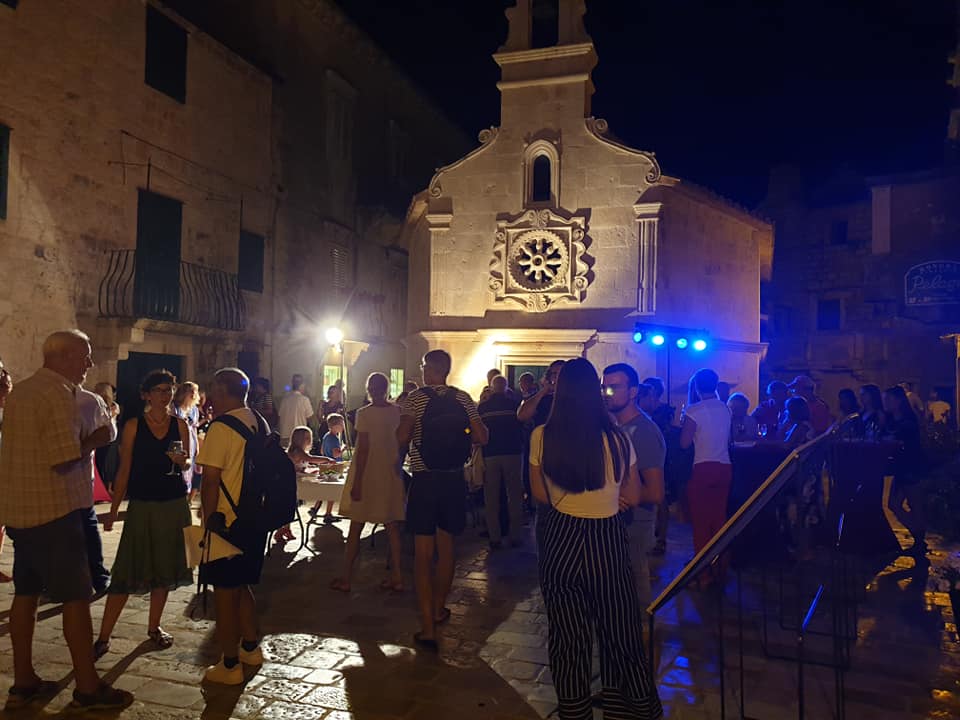
And yet for years Festa Vina has not really been associated with quality wine, which is somewhat ironic given that Jelsa has a proud wine tradition and today is home to a handful of the finest winemakers in Croatia. A chance to showcase the quality of the island's quality wines seemed somehow to get lost in the general party atmosphere, and for many years, the emphasis of the festival seemed to be more on beer and food brought from the mainland than local products and quality Hvar wine. So much so in fact, that the Hvar Wine Association decided no to attend Festa Vina a few years ago.
All that has changed in the last 3-4 years, with a much more concerted effort to return the focus to wine, and to celebrate the island's winemakers, who now occupy a prominent position on the waterfront with their wines available for tasting.
And to learn more about the origins of Festa Vina, the exhibition was full of surprises and great information. I should mention that some tourists complained to me that the exhibition was only in Croatian, which is true, although there is a very good English summary and timeline printout available - ask at the museum on Jelsa's prettiest square.
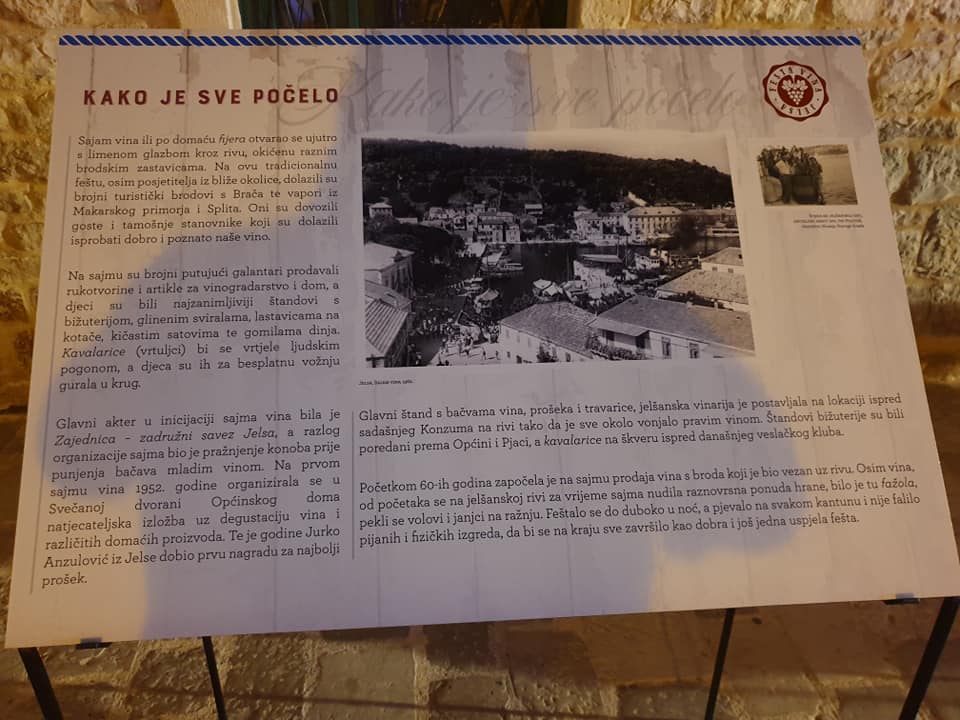
The first surprise was that the event dates back 67 years, all the way back to 1952. It was not a wine festival back then, but an agricultural fair, and it was conceived as a means to sell off all the old wines in the Jelsa cellars to make room for the new vintage. And it was certainly a huge success, with the statistics from 1957 reporting a staggering 60,000 litres of wine were sold, and "by the afternoon there was a shortage of cigarettes, bread, roasted meat, fruit and other supplies."
Initially known as The Regional Community Festival, the early events included brass bands from Jelsa, Stari Grad and Kastel Sucurac, water polo and football tournaments, theatre companies, national folk dancing, and a full-blown agricultural fair. People came in their boats and trucks to celebrate and buy wine to take home. Others were transported in steam boats from Split and the Makarska Riviera, and there was also organised transport from inland Dalmatia.
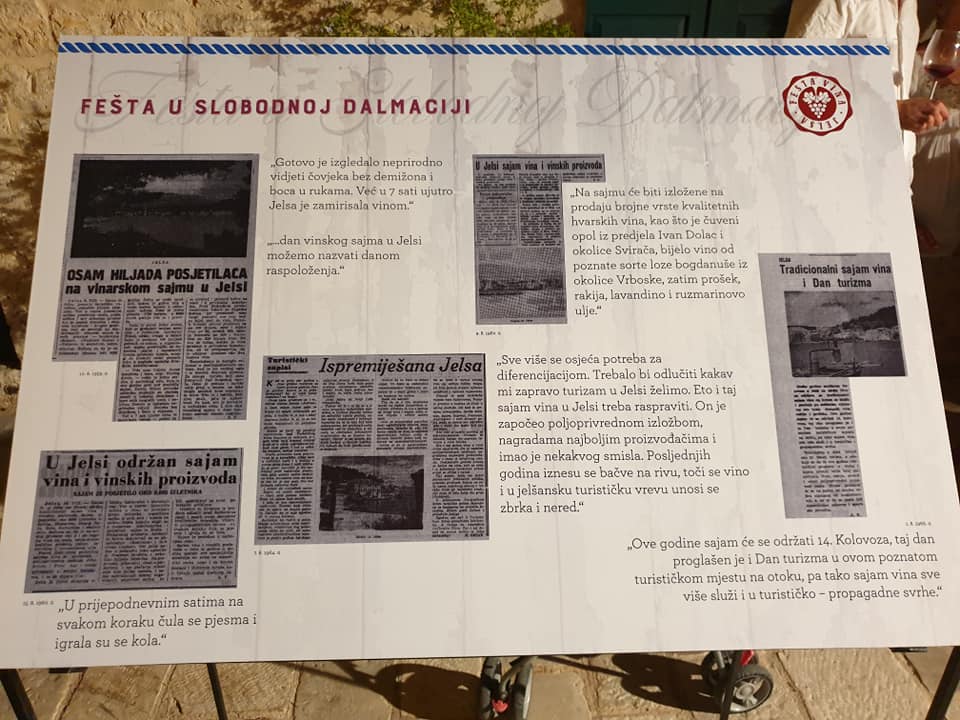
Business was certainly brisk, and the fair added to Jelsa's credentials as a top wine destination, but with so much alcohol flowing, it was inevitable that drunkenness occurred, which overflowed into violence (this in an era when the drunken British tourist had yet to be invented...), and despite the economic success, the fair was discontinued in 1969 or 1970.
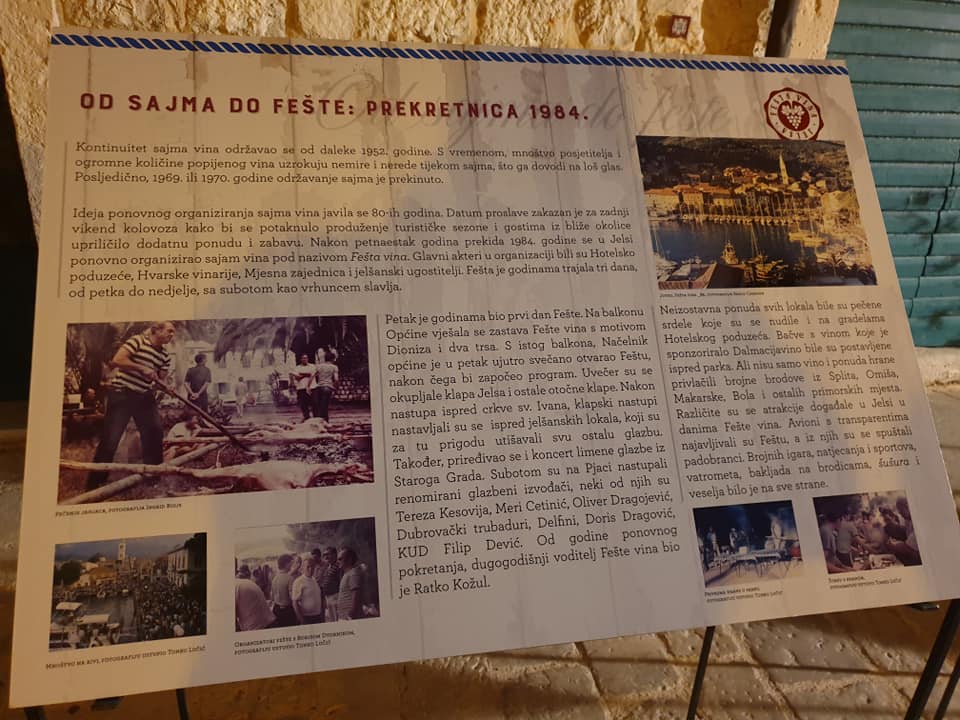
And that might have been the end of the story until it was decided to resurrect the event in 1984, but with a different focus - a wine festival. The main organisers were the hotel company, Hvar wineries, the local community council, and Jelsa's restaurant and cafe owners. Festa Vina was timed to be the last weekend of August so as to prolong the season a little.
"Grilled sardines were an indispensable part of the menu offered by the restaurateurs. The wine company Dalmacijavino sponsored the wine barrels which were placed in front of the park. But it was not only the wine and food which attracted the many boatloads of people from Split, Omis, Makarska, Bol and other coastal towns. There were lots of different attractions happening in Jelsa during the Wine Festival. Aeroplanes towing banners used to advertise the festival, and parachutists would jump out of them. There were many games, competitions and sports, fireworks, flares on small boats - there was a buzz and enjoyment on every side."
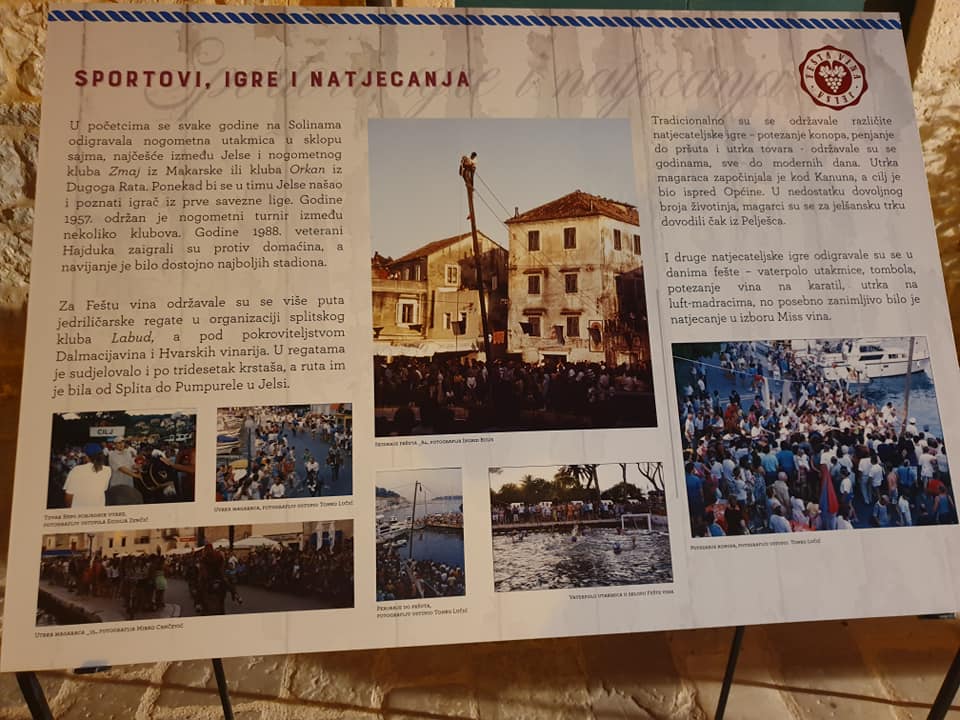
A few weeks ago, I published an article on how Jelsa could easily improve its tourism without spending much money. A key element of that strategy is developing a brand for the destination, which it currently does not have. As the most important wine town in Dalmatia, a slogan like Relaxed Family Lifestyle in the Dalmatian Wine Capital immediately gives Jelsa a focus and a personality. Events such as Festa Vina give content and history to that brand.
It is 77 years since it started, and Festa Vina has undergone several changes in that time. The current trend - to focus more on the quality wine aspect - is the best approach in my opinion. The big party is tonight - see the programme below.
See you there?
If you are looking to learn more about the Dalmatian wine capital, check out 25 things to know about Jelsa.
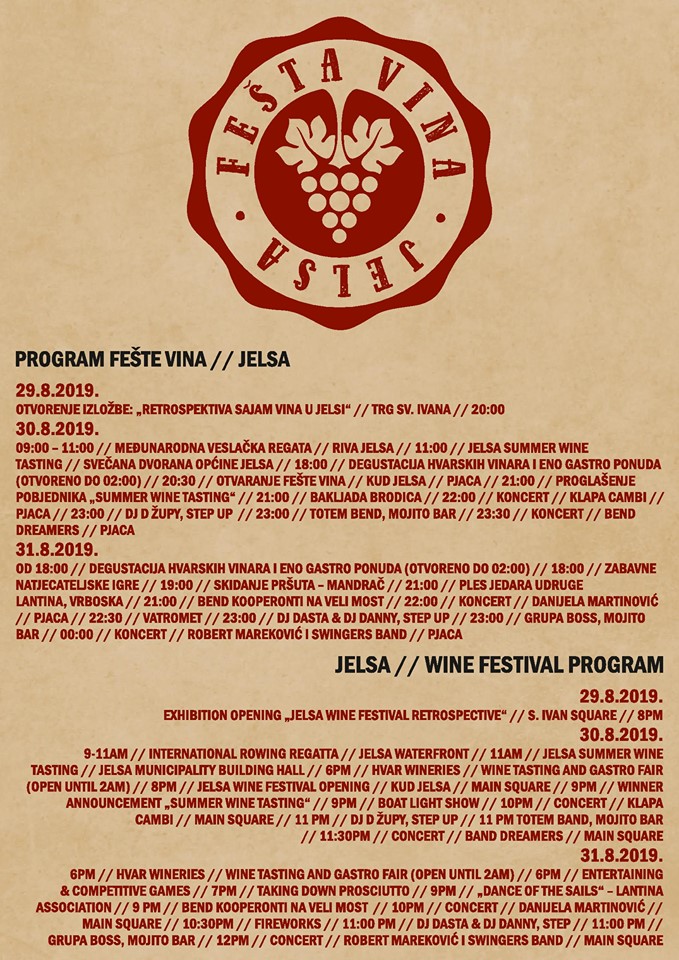
Little Luxury, Pricey Mass Tourism: TCN Interview with Tportal on Croatian Tourism
August 3, 2019 - Total Croatia News featured in a big article in Tportal today, entitled 'Crazy Englishman from Jelsa' - Guys, snap out of it, Croatia does not have a luxury tourism product and is too expensive for mass tourism. Here is what I suggest' by Damir Petranovic. An English translation.
Seventeen years after he first set foot on the island, the '’crazy Englishman from Jelsa’' - as the locals quickly took to calling him - has given this little Hvar town a real tourism strategy.
"Some Simple Steps to Improve the 2 Star Tourism Strategy in Jelsa on Hvar" is the title of an extensive article published on Bradbury's Total Croatia News (TCN) portal, which easily diagnosed the causes of stagnation and suggested a number of coherent and concrete proposals for a radical turnaround. In an interview with tportal, he explained what he wanted to achieve, but as now a great connoisseur of opportunities, he also addressed the possible implications at the national level.
This Brit has been known for many years as one of the best promoters of Croatian tourism, but at the same time one of the biggest critics of how it is being managed: among the most well-remembered are, let’s say, his devastating analysis of the ‘'Croatia 365’' project or the recent announcement that ‘’there would be no less tourists coming tomorrow if we abolished the Croatian National Tourist Board’’, Still, the positives prevail, and so Bradbury’s biography boasts a series of remarkable ventures.
Firstly, upon his arrival to Hvar, he issued the first complete tourist guide on the island, then realised that there was enough news there to launch a local portal, then on the same principle as Total Hvar, he launched Total Split, Total Inland Dalmatia, Total Zagreb and Total Dubrovnik, and finally Total Croatia News, named the most influential Croatian medium in the English language, affiliated with Google News. This was followed by the launch of portals specialised in cycling, wine and sailing, followed by the unofficial title of the most influential Croatian blogger, various workshops and entrepreneurial ventures. A few years ago, he moved to Varazdin.
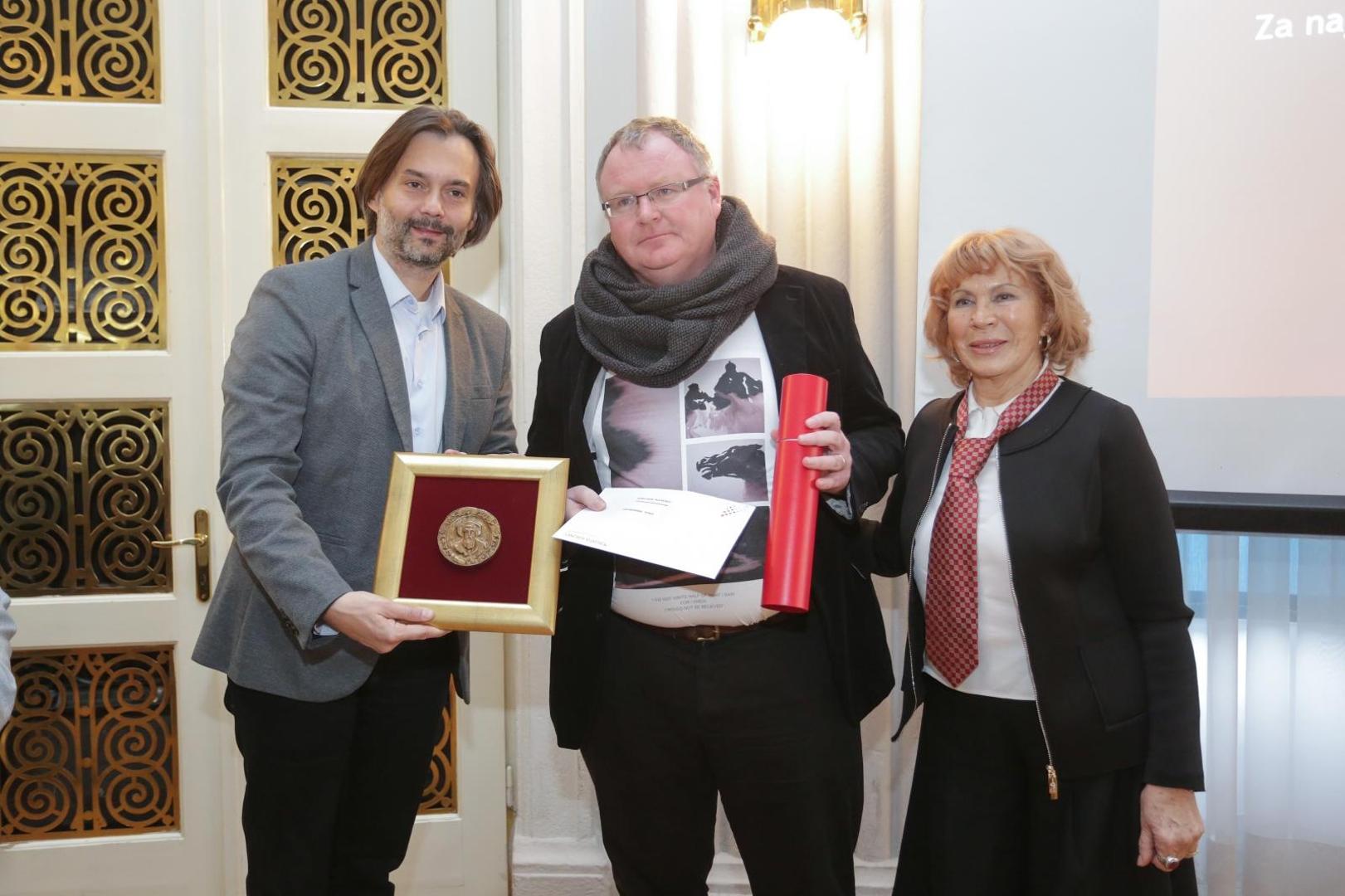
He is the only person to win the FIJET Marco Polo award at the National Society of Journalists twice – in 2014 for best international promotion of Croatia, and in 2017 for a feature on Advent in Zagreb – and he has been invited to submit his work on medical tourism to the inaugural Malaysia Healthcare Travel Council media awards in Kuala Lumpur later this month.
Bradbury, a man with a rich biography and over 90 travelled countries, ended up almost by accident in Croatia. He admits that he lived in a kind of bubble until he realised the meaning of the word '’uhljeb’', and from that period on, his observations were unavoidable reading for a better understanding of Croatian reality, while at the same time, his Facebook profile was both fun, sad, and educative. and instructive.
Just last month, he began posting short videos there from the July peak season in Jelsa. Snapshots of the half-empty town square were an overture to him in anticipation of the results of this year's tourism statistics, but also the basis for the great article mentioned in the introduction. In it, he referred to the ‘'all-inclusive'’ practice that has little or no benefit to the local community, excursion boat tours that bring thousands of tourists to Jelsa just to get ice cream there and look back confused because they have no idea how to fill those few hours, as well as today's unsuccessful branding of a place with exactly 108 years of organised tourism.
And then he suggested some concrete measures - from promoting Jelsa as the Dalmatian wine capital, organising sports events and optimising cooperation with neighbouring towns and islands, to, say, a concrete connection with a Norwegian town also called Jelsa. We will not retell Bradbury's theory, because the article is really worth reading (English version link at the top of this article, Croatian version here), like his suggestion for branding Croatia and improving tourism at the national level and resetting Croatian tourism - Branding Croatia: 5 Trends and Gifts to Focus On.
We therefore asked Bradbury to look at some other, related topics in a quick, layman-like way for tportal.
What are the reactions in Jelsa to this article?
I am not in Jelsa at the moment, so I can't really answer that question. Perhaps the most interesting response was a public one from the phenomenal Run Croatia project, who are very keen to work with Jelsa to initiate the first-ever Run Croatia Week. A great first step to restoring Jelsa's sporting traditions. The way that Run Croatia is expanding, having Jelsa as a flagship first destination for a Run Croatia Week could be the start of something beautiful. As you see below, they are only waiting for Jelsa's call to get started.
You mentioned a lawsuit from the Mayor – can you be more specific?
You will have to ask the Mayor. He chose to announce it in a public meeting in Vrboska a year ago. As I still haven't received the lawsuit, I am not sure what it is about.
What was the motivation for doing this kind of story?
My main motivation was sadness. Sad that such a lovely destination which has been so good to me over so many years is offering such poor tourism, and friends in the tourism business are suffering for no reason. As you can see from my article, my suggestions are not rocket science. They are simple to implement, cost mostly nothing, and will have a very positive effect as soon as next year. See Run Croatia above.
Is this problem specific for Jelsa, or can some of this advice be applied to Croatian tourism in general?
Yes, I think almost all of it can be applied elsewhere. There is nothing complicated in what I suggested, but sometimes it takes a foreign eye to give a different viewpoint. The big question is what does Croatian tourism offer on the coast? And the answer, sadly, is very little apart from the sun and the sea. And as we have seen with the weather this season, we can't even guarantee that now. Does Croatian tourism have a Plan B when climate change really kicks in?
What are your impressions of Croatian tourism in general – this season, and compared to 2002?
Everyone got really excited in the last few years as tourism was booming, as though it was due to some kind of strategic plan, and everyone was 'doing tourism' and making cash which meant to them handing over an apartment key and taking the cash. In reality, due to terror attacks and other circumstances, tourists to Egypt, Turkey, Tunisia, even Greece to a point, were looking for somewhere to go. Croatia couldn't lose. And did they try and see if they could win these guests for the long term? No. The prices were high, the service poor, and there was nothing to do apart from the sun and the sea. So when Turkey etc were safe once more, where do you think they went?
So Croatia can't compete in terms of price with these cheaper destinations in the mass tourism market which offer much better value. And it cannot compete at the luxury end, as there are no hotels (there are about 6 billion euro in blocked projects on the Adriatic). Check how many luxury hotel brands there are in tiny Montenegro (6 times less coastline, only 11 islands), for example, then check in Croatia.
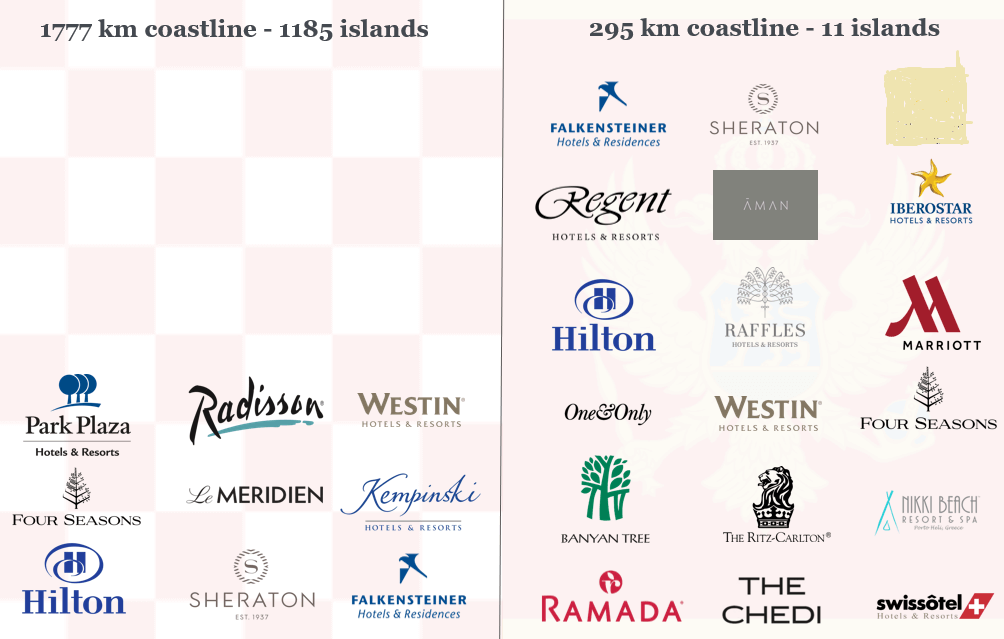
Business Insider researched luxury tourism providers to find out where the top 15 countries billionaires were visiting in 2019. Montenegro was in there, so was Rwanda. Croatia? Not a chance.
So in 2019, after years of being Full of Life, what is Croatia as a destination? Hardly anything to offer the luxury market, too expensive for the mass market. I think Istria is an exception to this, and tourism is working much better there. But there really is no brand, and no real offer, and it is expensive.
I have been doing a series of interviews on tourism businesses having record years in recent days to find out what they were doing. Vanja from Adriatic Travel Collection is doing incredible things in top luxury tourism in Croatia and I recommend her interview to your readers.
And I couldn't agree more with this sentence:
I am also tired of people who always complain. They have to start changing their offer, finding their niche. 80’s tourism is in the past and the majority are still offering just that, sun and sea. It is actually that simple.
I have never been one just to criticise without offering something constructive. I think Croatian tourism needs a complete reset, and here is how I would do it.
Jelsa in 2002? I obviously have a very romantic memory of that time, having just arrived and meeting my future wife in the Jelsa library, so it is hard to compare. But it seemed that locals tried harder with their tourists back then, that there were more relationships. Tourists were more loyal to destinations back then, these days it is all about the Instagram checklist.
Lately there was a lot of talk about the Croatian National Tourist Board, some people said it's useless an no one would notice if it was shut down. What is your opinion on that?
Well I gave an interview in the Croatian media last week which was read over 100,000 times called Brit who lives in Croatia: If the Croatian National Tourist Board was abolished tomorrow, there would be no fewer tourists. Maybe the title answers the question.
Where do you see Croatian tourism in the next few years?
It could be incredible, really incredible. Or it could be a worsening version of what we have today. As in every other section of Croatian society. I think we all know what the main problem in Croatia is.
Many international experts agree, for example, that Croatia could be in the top 10 in the world within 10 years for this lucrative, 12-month, and rapidly expanding medical tourism industry. If Croatia could gets its act together and the stakeholders unite. Learn more in Can Croatian Officials Unite to Exploit Huge Medical Tourism Opportunity?
But that is the story of every part of Croatian society. The system has to change, but will people get on the streets and demand change? They only get on the streets to celebrate football and heroes like Oliver. I suggested recently that we name a National Keyboard Warrior Offline Day, and get all our keyboard warrior heroes who spit hate and dissatisfaction to go offline for one day and all assemble in Zagreb and demand change. Haha, right, as though that might happen.
Why Jelsa's Tourism Future is Bright: Explained in 1 Tourist Facebook Post
August 3, 2019 - While Jelsa may be having a poor season with its current 2-star tourism strategy, the future is very bright indeed - listen to what the tourists are saying after they discover the secrets Jelsa doesn't share.
I have spent a bit of time this summer looking at the current state of tourism in my beloved Jelsa on Hvar. Saddened by the poor quality in a destination which could do so much better, I decided to give something back to the town which has given me so much - a proper tourism strategy, much of which can be implemented in time for next season. You can read Some Simple Steps to Improve Jelsa's 2-Star Tourism Strategy on Hvar, as well as a Croatian version here.
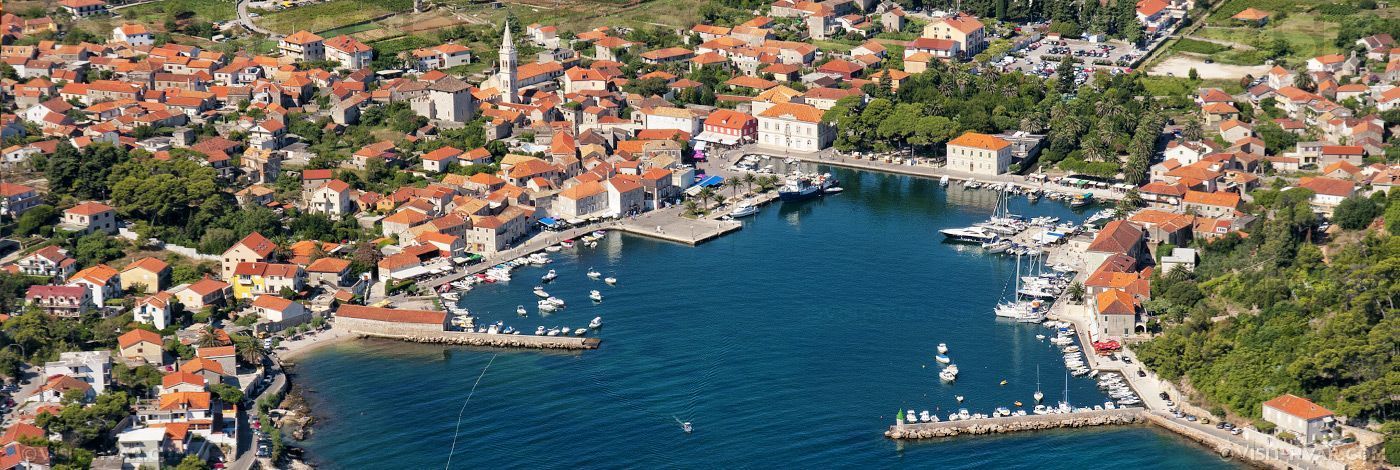
One of the key failures of Jelsa currently, after 108 years of tourism, is that nobody knows what Jelsa's brand is. There is something vague about it being a relaxing place, family-friendly, good wines. Nothing more. One local probably summed the general feeling better than most:
Jelsa today is not "branded". Now regarding the type of destination, I'd say it's a reasonably pleasant, family-friendly town
It doesn't exactly get you booking your flight, does it?
My suggestion (and you can read more in the link above) is to brand Jelsa as the Relaxed Family Lifestyle in the Dalmatian Wine Capital.
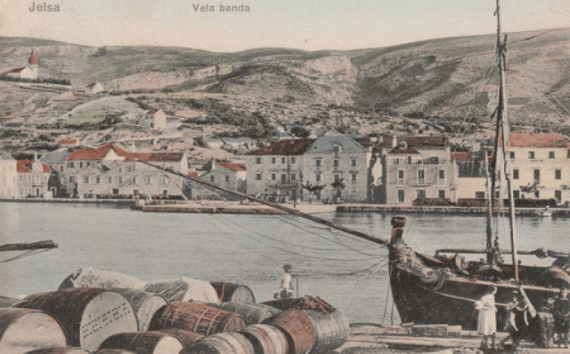
I want to tell you about one guest who rented our place recently. After arriving in Jelsa (and possibly through the information we made available, but not necessarily), he heard that there was a British Master of Wine somewhere near Jelsa, the only one in all Croatia.
With no car, the couple went off in search of the winery of Jo Ahearne MW, but ended up in the wrong village, in Pitve, before finally tracking down the winery in Vrisnik. They were disappointed to find it closed (Jo does tastings by appointment generally, as she is a one-woman band and there is plenty to do elsewhere). I am not in Jelsa at the moment, and when I spoke to my wife that evening, she mentioned that the guests were very keen to taste her Rosina rose in particular. Jo is a good friend of mine and I knew that she was playing with her Posip grapes on Korcula. I messaged her to find out when she was back, and it turned out there was a window before the guests left the island where she could accommodate them. As they had no car, my wife happily drove them to Vrisnik. As for the rest, I leave it to the Facebook comment on Jo's winery's Facebook page:
We did not know anything about the Dalmatian wine scene before coming to Hvar, and was prepared to drink beer and water as we have done on previous occasions. To our great surprise the island of Hvar has an immigrated master of wine in Jo Ahearne (you will only find around 400 masters of wine in the world, it is not like any other college degree), living only ten minutes drive from where we stayed in the beautiful city of Jelsa. We booked a tasting of her bottled wines (two whites, one rose and two reds), and was blown away by the quality of her winemaking. She uses mostly local grape varieties (Posip, Drnekusha and Plavac Mali). This is a totally different ballgame than other wines we have tried in Croatia, and absolutely worth a trip if you are into wine. Drenkusha is for example an indigenous grape found on the island, almost extinct, and in Jo´s hands turned into top-notch rose (which also landed a 90 point rating in the English wine magazine Decanter this July). Thank you for a great visit, we look forward to drink all the bottles that we brought home.
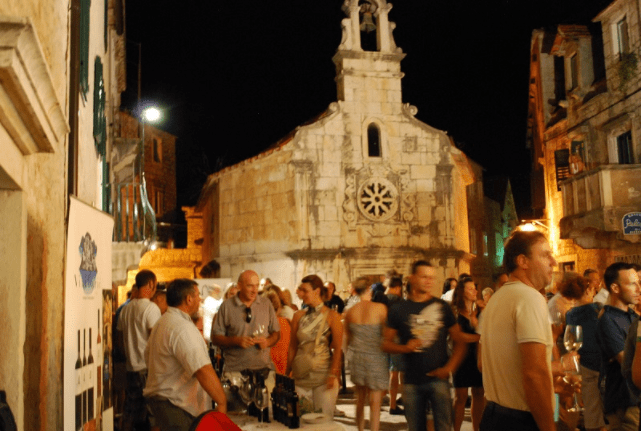
Fantastic, a win all round. Very happy guests, a successful tasting and some money in the pocket of a local business. Bottles purchased to take home and sample, perhaps with friends who could then learn more about Dalmatian wine and its capital.
But the post got me thinking. Everything about the story was 'slucajno' - accidental. The guest happened to hear about the Dalmatian wine scene, then about Jo. The tasting was finally arranged late at night (after 10pm) because the host happened to be a friend of the Master of Wine.
What IF the guests had known about the Dalmatian wine capital before arriving? While Jo is the undoubted star of the Hvar wine scene, there are many other winemakers in and around Jelsa who provide diverse and fascinating wine tasting options. I went into this at some length recently with my concept to brand Hvar as a gourmet destination - The Dalmatian Wine Capital with the UNESCO Mediterranean Diet.
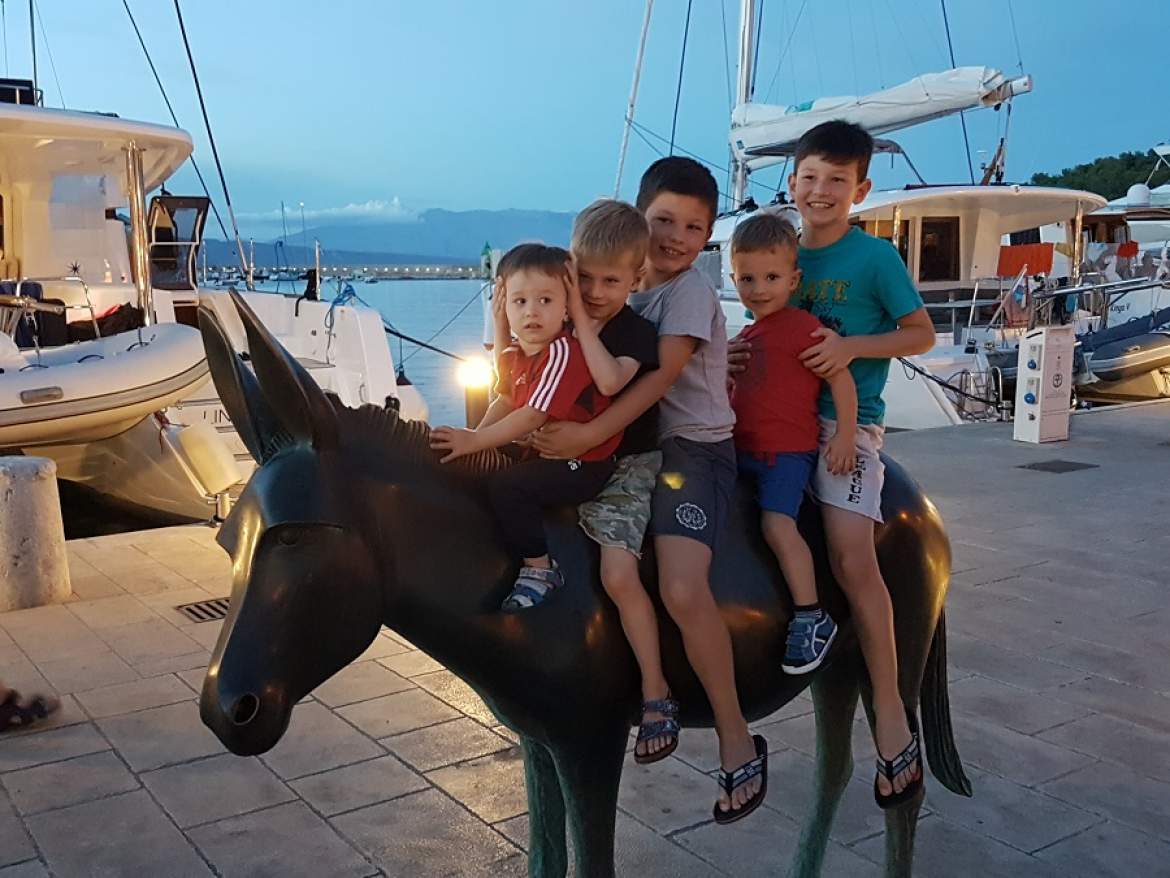
What if instead of Jelsa today is not "branded". Now regarding the type of destination, I'd say it's a reasonably pleasant, family-friendly town, we changed it to the Relaxed Family Lifestyle in the Dalmatian Wine Capital.
"Hey honey, take a look at this place, it looks perfect. It is the capital of Dalmatian wine, with some great tasting experiences. The island's Mediterranean Diet is UNESCO-protected, so I bet the food is healthy and good. This Jelsa place apparently has great beaches, has a chilled lifestyle, great day trips, is very safe, laid back and family-friendly with a great little square for morning coffee and croissants. So lots to do with the kids, and all those indigenous grapes look really exciting to explore. Heck, they even have a British Master of Wine doing tastings of her wines made from indigenous Hvar grapes. What do you say, shall I see if I can find some nice accommodation with a terrace and sea view? It looks gorgeous."
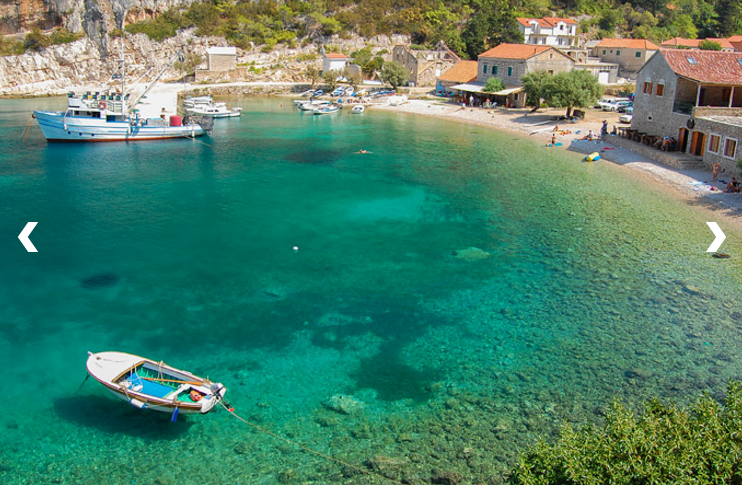
Learn more about the Jo Ahearne MW tasting experience just a couple of kilometres outside Jelsa.
Interested to learn more about Jelsa? 25 things to know about Hvar's (and Dalmatia's) wine capital.
Lies, Damned Lies and Croatian Statistics Said Mark Twain, Kind Of
August 3, 2019 - A deeper look into the tourism statistics in Jelsa on Hvar points to the realities of season 2019 in Croatia beyond the headline numbers.
Statistics are such useful things. On the one hand, they can be used to track progress on things, while on the other, they can be interpreted in certain ways to fit a particular narrative.
And when - as is the case with the Croatian tourism chiefs - the powers that be decide that statistics (and their interpretation of them) will be the biggest barometer of success, then having control of public opinion of the interpretation of those statistics becomes crucial.
And so when the Ministry of Tourism decided to restrict access to the transparent, award-winning, real-time eVisitor statistics reporting system, I was not the only one who was suspicious that there was something 'going on.'
Some people think I am a tourism expert because I write a lot about Croatian tourism. I am not. I am a former male chambermaid turned wine merchant turned aid worker turned English teacher in Japan turned real estate agent turned writer. My first article published online was less than 8 years ago.
My understanding of Croatian tourism is still evolving, and I - like many others - was impressed at the growth of tourism in Croatia. Record number of tourists, record overnight stays. It was all good.
Or was it?
The overtourism debate in Dubrovnik started to spill over to other places on the coast, and somewhere along the way, the charm of the Dalmatian coast (I am referring mostly to the Adriatic coast here, and would also like to point out that little of this refers to Istria) seemed to be getting lost with an ever-increasing influx of tourists on the mainland. Were all these extra tourists a good thing, and were they actually spending to compensate for the inconvenience?
There has been a growing call in recent months for cruise ships to be limited, to have a general rethink on the tourism strategy. This mass tourism strategy is not healthy, and anyway Croatia cannot really compete with the likes of Turkey, Tunisia and Egypt, who are all now back in competition after recent terror attacks. And as there is a severe lack of quality hotels, luxury tourists are looking elsewhere.
But the statistics. If statistics are the thing you have decided to be judged on, then statistics you must deliver at any cost. The quality of the tourism has become less important than the statistics. If Minister Cappelli can announce that last year's record overnights of 106 million (54 million more than in 1990) has been exceeded, then he can officially declare the season a success and a vindication of his 'strategy.'
But is it? Is judging a tourist season by its arrivals and overnight stays the way to measure success? If we all worship at the Temple of Record Overnight Stays and feed it more and more overnights to make the temple bigger, is that what we call success? Or a strategy?
Statistics. As Mark Twain famously wrote, there are lies, damned lies and statistics. Let's take a closer look.
As readers of TCN will know, I have been following the season very closely in my adopted hometown of Jelsa on Hvar this summer. I felt saddened enough by the low-quality tourism that this lovely town is now enduring, while at the same time enjoying a lovely summer - the empty Jelsa of summer 2019 is as nice as I have known it. And if you have not booked a holiday yet, then come! There are some great offers for an affordable holiday, as we will discover below.
The statistics for the 2019 season to the end of July are now finally available, so let's dive in to see how Jelsa is doing, as it seemed so empty in July. And remember, statistics can be interpreted to suit any narrative.
The first surprise in such a seemingly empty destination is that tourist arrivals are actually UP! By 1.44% compared to this time last year. Is this the World Cup dividend finally coming to light?
But then, if you wanted to write a negative narrative, you could say that the overnight stays were down 0.91%
Either way, this is a good season, isn't it? What the hell is that fat, pink Brit complaining about?
Here are the arrivals and overnight stays by country for the first 7 months. In Minister Cappelli's Kingdom of Accidental Tourism, All Overnight Stays are Equal.
As a foreign fly on the wall, I beg to differ. I think that overnight stays from countries who are also going to spend in the bars, restaurants and on tours are worth more than those bringing their own food and drink and looking for the cheapest option to have their summer holiday on the beach. But he is the minister and I am just a blogger, so what would I know.
If we look at the overnights so far, the only countries which are up are from Eastern Europe (big welcome to our friends from Ukraine, up 177%). If we look at who is down, we have Austria (-20%), Norway (-19%), UK (-12%), Italy (-14%). The higher spending East Europeans are also down (Poland and Serbia - 10%).
Not great news for the restaurants.
These are the numbers for July, the month I was documenting - while Norway was down almost 30%, Bosnia was up 12%. We will figure out why in a moment.
If we look at the hotels in Jelsa, they are having a great season - at least the main two are - 15% more arrivals than last year. Great news for Minister Cappelli's spreadsheet.
So who is staying in the hotels, and where are the biggest increases coming from? Ukraine (269% on overnight stays), Slovenia (30%) and Bosnia (20%). It is nice to see that there are 13% more Croatians in Jelsa this year - many complain that the coast is too expensive for them these days, especially islands such as Hvar. So why the big increases in the hotels from places like Bosnia and Ukraine, for example?
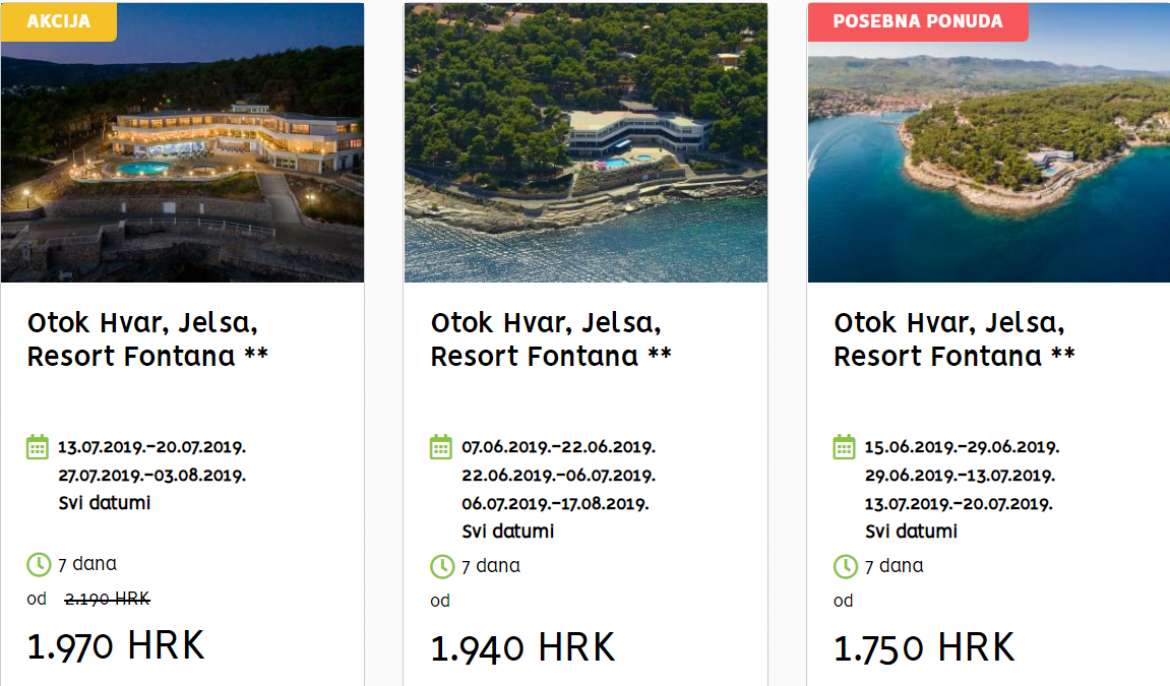
Could it be something to do with price, perhaps? An example of some of the offers for Jelsa hotels being discounted already this summer. In the cheapest offer of them all (available for the first three weeks of July), 2 adults (1,750 kuna each) and one child under 12 (free) could have a week in a hotel room close to the sea and a great beach, with breakfast and dinner, free WiFi and parking for just 3,500 kuna inclusive.
Or 166 kuna per day per person.
That includes the agency fee, taxes, running costs, and all the rest.
Expensive Hvar? Never was it so affordable! We live 100 metres from the hotel and only half-jokingly talked about moving in for a week to save money. A REALLY good value holiday, and with such an excellent beach and everything in the hotel, no need to go and spend downtown. Perhaps on an ice cream for the little one.
In Minister Cappelli's Temple of Record Overnights, All Overnights are Equal.
And just in case you are cursing yourself for missing out on such a bargain, relax. There is still time. It will cost you 39 kuna a day extra now in August, but that family of three can enjoy magical Jelsa for just 205 kuna a day. Book here. 21 more overnights for the hallowed spreadsheet.
How is it going in private accommodation? Up with East Europeans, down with Germany, Austria and Norway.
Camping has always been one of Jelsa's accommodation strong points. With several camps within walking distance of the catamaran, it is the perfect place for camping tourists to base themselves when coming to Hvar.
Not this year.
Perhaps the most surprising - and alarming - statistics are in this table.
After 108 years of tourism in the town, nobody still has any idea what Jelsa's brand is. Most people talk about it being a family destination. More a destination for old people and teenagers these days it seems, rather than young families and parents aged 25-44.
So what have we learned?
Jelsa is extremely good value, with bed, breakfast and dinner available even today from 205 kuna per person per day. Tourists from the region are taking advantage of those offers and then staying within the hotels, while the traditional higher-spending guests from places like Germany, Austria and Norway are going elsewhere, which is leaving the restaurants and the town considerably emptier.
It is the worst kind of tourism Jelsa could have, but Minister Cappelli will be able to preach from the pulpit at the Temple of Record Overnight Stays about how well Croatian tourism is doing.
Just make sure you don't ask him to explain the World Cup tourism dividend.
In this era of manipulated information, some will cry Fake News. Others will not believe something unless they see it. A quote from my recent blueprint to improve Jelsa tourism, Some Simple Steps to Improve Jelsa's 2-Star Tourism Strategy on Hvar.
I posted quite a few of these on my Facebook wall (apologies to my FB friends) because I wanted to document the reality when the inevitable will happen when the statistics are announced. We will be blinded by science and spreadsheets about numbers and overnights. Those Ukranian 21 overnights will cover up the real situation to save some ministerial embarrassment. As the hotels are filling with low-cost half-board tourists, the restaurants are complaining that the higher-spending guests, such as Norwegians, are a lot less this year. Does 21 Ukrainian half-board overnights equal 21 Norwegians in private accommodation and eating in the restaurants and drinking in the bars? For the spreadsheets, they are the same. For tourism revenue to Jelsa businesses, I would put the ratio at 21:3.
For the more visual types, a selection of videos of Jelsa's tourist season in July, shot at different times of the day. I am sure Minister Cappelli can only see packed tables and a main square Full of Life.
July 8, 2019. 19:25
July 8, 2019. 20:45
July 8, 2019. 22:00
Jelsa, 18:45, July 13
19:45, July 13
21:00, July 13
21:45, July 13
July 16, 2019, 20:35
July 16, 22:55
July 20, 12:30
July 20, 12:40
July 20, 19:10
July 20, 2019 at 21:00
July 21, 20:30
July 21, 20:40
July 21, 22:40
July 22, 19:35

